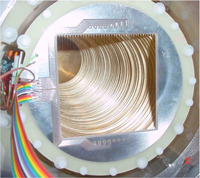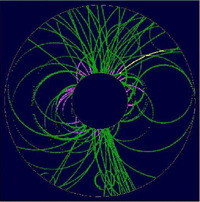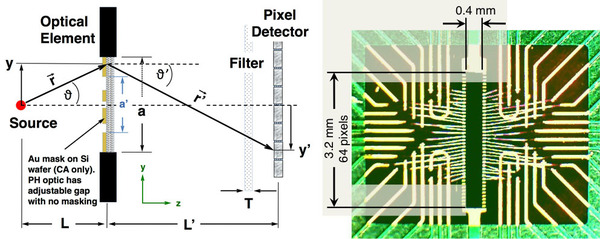Instrumentation R&D for HEP Experiments
Time Projection Chamber for ILC

A prototype TPC used to study different readout schemes.
The
International Linear Collider (ILC) is an electron-positron collider with an initial collision energy of 500 GeV, upgradable to 1 TeV. It will explore the TeV energy scale, shedding light on the physics that lies there. It will complement, and build upon, the discoveries of the LHC.
Cornell is developing Time Projection Chamber (TPC) technology for the ILC. We have built a
prototype equipped to compare the performance of GEM, MicroMegas and traditional pad readout. Cornell is also involved in planning for a large-scale international prototype.
We are also developing TPC reconstruction
software.
Researcher:
Dan Peterson
Sensor R&D for a Pixel Detector for ILC

A sample event, e+e- → ZH, in the LCD candidate detector illustrates the complications from overlapping tracks.
The detectors at the ILC face major challenges, quite different from those at hadron colliders. While ILC detectors will work at lower event rates, with lower backgrounds and lower radiation doses than those at LHC, they impose more stringent requirements on precision. Excellent vertex detection and resolution on jet energy are required, as well as hermeticity for particle searches, very good track momentum measurement, and the ability to explore the full physics content of an event through high granularity detectors. Our Sensor R&D group studies various options for a vertex silicon pixel detector, using simulations, and fabrication of prototypes for tests of various cutting-edge sensor technologies. These include pixel sensor designs using SOI technology, and active-edge planar strip sensors to be used as part of a fully active 3D integrated tile.
Faculty:
Julia Thom-Levy
X-ray Beam Size Monitor for ILC
The experimental high-energy physics group is collaborating with accelerator physicists on an
x-ray beam size monitor as part of the
CesrTA project, with the ultimate goal of deploying such a device at the
International Linear Collider.

X-ray beam size monitor optics (left) and photo-diode pixel detector (right). Source to optics L~4m. Optics to detector L'~10m.
The X-ray beam size monitor,
(xBSM) is an instrument for measuring the sizes of the electron and positron beams using synchrotron radiation.
The device can measure vertical beam sizes of 10–100 μm on a turn-by-turn, bunch-by-bunch basis at beam energies of ~2GeV. The xBSM images X-rays
that emerge from a hard-bend magnet through a single- or multiple-slit (coded aperture) optical element onto an array of 32 InGaAs photodiodes.
Beamlines and detectors are entirely in-vacuum, enabling single-shot beam size measurement down to below 0.1 mA (2.5 billion particles) per bunch and inter-bunch spacing of as little as 4 ns.
A systematic precision of ~1 micron is achieved for a beam size of ~12 microns.
Achieving this precision requires comprehensive alignment and calibration of the detector, optical elements, and X-ray beam.
Data from the xBSM have been used to extract characteristics of beam oscillations on long and short timescales, and to make detailed studies of low-emittance tuning, intra-beam scattering, electron cloud effects, and multi-bunch instabilities.
Researchers:
James Alexander,
Dan Peterson,
Brian Heltsley



